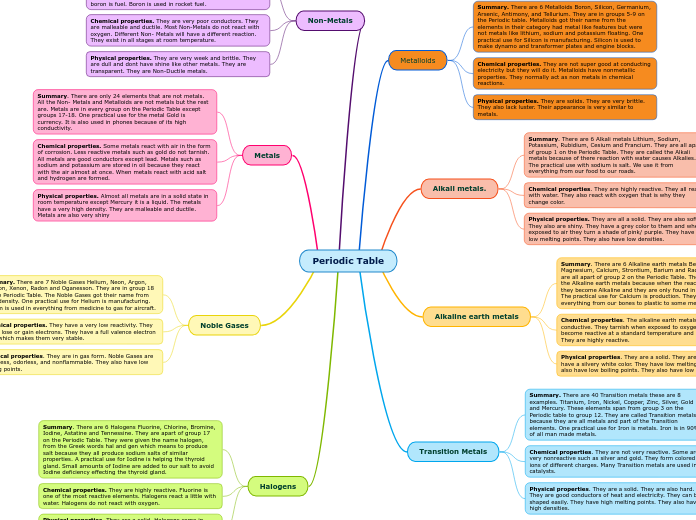
Summary. There are 6 Metalloids Boron, Silicon, Germanium, Arsenic, Antimony, and Tellurium. They are in groups 5-9 on the Periodic table. Metalloids got their name from the elements in their category had metal like features but were not metals like lithium, sodium and potassium floating. One practical use for Silicon is manufacturing. Silicon is used to make dynamo and transformer plates and engine blocks.
Chemical properties. They are not super good at conducting electricity but they will do it. Metalloids have nonmetallic properties. They normally act as non metals in chemical reactions.
Physical properties. They are solids. They are very brittle. They also lack luster. Their appearance is very similar to metals.
Summary. There are 6 Alkali metals Lithium, Sodium, Potassium, Rubidium, Cesium and Francium. They are all apart of group 1 on the Periodic Table. They are called the Alkali metals because of there reaction with water causes Alkalies. The practical use with sodium is salt. We use it from everything from our food to our roads.
Chemical properties. They are highly reactive. They all react with water. They also react with oxygen that is why they change color.
Physical properties. They are all a solid. They are also soft. They also are shiny. They have a grey color to them and when exposed to air they turn a shade of pink/ purple. They have low melting points. They also have low densities.
Summary. There are 6 Alkaline earth metals Beryllium, Magnesium, Calcium, Strontium, Barium and Radium. They are all apart of group 2 on the Periodic Table. They are called the Alkaline earth metals because when the react with water they become Alkaline and they are only found in the ground. The practical use for Calcium is production. They are in everything from our bones to plastic to some metals.
Chemical properties. The alkaline earth metals are conductive. They tarnish when exposed to oxygen. They become reactive at a standard temperature and pressure. They are highly reactive.
Physical properties. They are a solid. They are shiny. They have a silvery white color. They have low melting points. They also have low boiling points. They also have low densities.
Summary. There are 40 Transition metals these are 8 examples. Titanium, Iron, Nickel, Copper, Zinc, Silver, Gold and Mercury. These elements span from group 3 on the Periodic table to group 12. They are called Transition metals because they are all metals and part of the Transition elements. One practical use for Iron is metals. Iron is in 90% of all man made metals.
Chemical properties. They are not very reactive. Some are very nonreactive such as silver and gold. They form colored ions of different charges. Many Transition metals are used in catalysts.
Physical properties. They are a solid. They are also hard. They are good conductors of heat and electricity. They can be shaped easily. They have high melting points. They also have high densities.
Summary. There are 17 Non Metals. Here are 11 of them. Hydrogen, Boron, Carbon, Nitrogen, Oxygen, Silicon, Phosphorus, Sulfur, Arsenic, Selenium, Tellurium. They are in groups 1 and 5-8 on the Periodic Table. Non- Metals got their name because they are not metals. One practical use for boron is fuel. Boron is used in rocket fuel.
Chemical properties. They are very poor conductors. They are malleable and ductile. Most Non-Metals do not react with oxygen. Different Non- Metals will have a different reaction. They exist in all stages at room temperature.
Physical properties. They are very week and brittle. They are dull and dont have shine like other metals. They are transparent. They are Non-Ductile metals.
Summary. There are only 24 elements that are not metals. All the Non- Metals and Metalloids are not metals but the rest are. Metals are in every group on the Periodic Table except groups 17-18. One practical use for the metal Gold is currency. It is also used in phones because of its high conductivity.
Chemical properties. Some metals react with air in the form of corrosion. Less reactive metals such as gold do not tarnish. All metals are good conductors except lead. Metals such as sodium and potassium are stored in oil because they react with the air almost at once. When metals react with acid salt and hydrogen are formed.
Physical properties. Almost all metals are in a solid state in room temperature except Mercury it is a liquid. The metals have a very high density. They are malleable and ductile. Metals are also very shiny
Summary. There are 7 Noble Gases Helium, Neon, Argon, Krypton, Xenon, Radon and Oganesson. They are in group 18 on the Periodic Table. The Noble Gases got their name from their density. One practical use for Helium is manufacturing. Helium is used in everything from medicine to gas for aircraft.
Chemical properties. They have a very low reactivity. They rarely lose or gain electrons. They have a full valence electron shell which makes them very stable.
Physical properties. They are in gas form. Noble Gases are color less, odorless, and nonflammable. They also have low boiling points.
Summary. There are 6 Halogens Fluorine, Chlorine, Bromine, Iodine, Astatine and Tennessine. They are apart of group 17 on the Periodic Table. They were given the name halogen, from the Greek words hal and gen which means to produce salt because they all produce sodium salts of similar properties. A practical use for Iodine is helping the thyroid gland. Small amounts of Iodine are added to our salt to avoid Iodine deficiency effecting the thyroid gland.
Chemical properties. They are highly reactive. Fluorine is one of the most reactive elements. Halogens react a little with water. Halogens do not react with oxygen.
Physical properties. They are a solid. Halogens come in many different colors such as pale yellow, red, purple and yellowy green. It all depends on the element to determine what color it is. They have low melting points. They also have low boiling points.